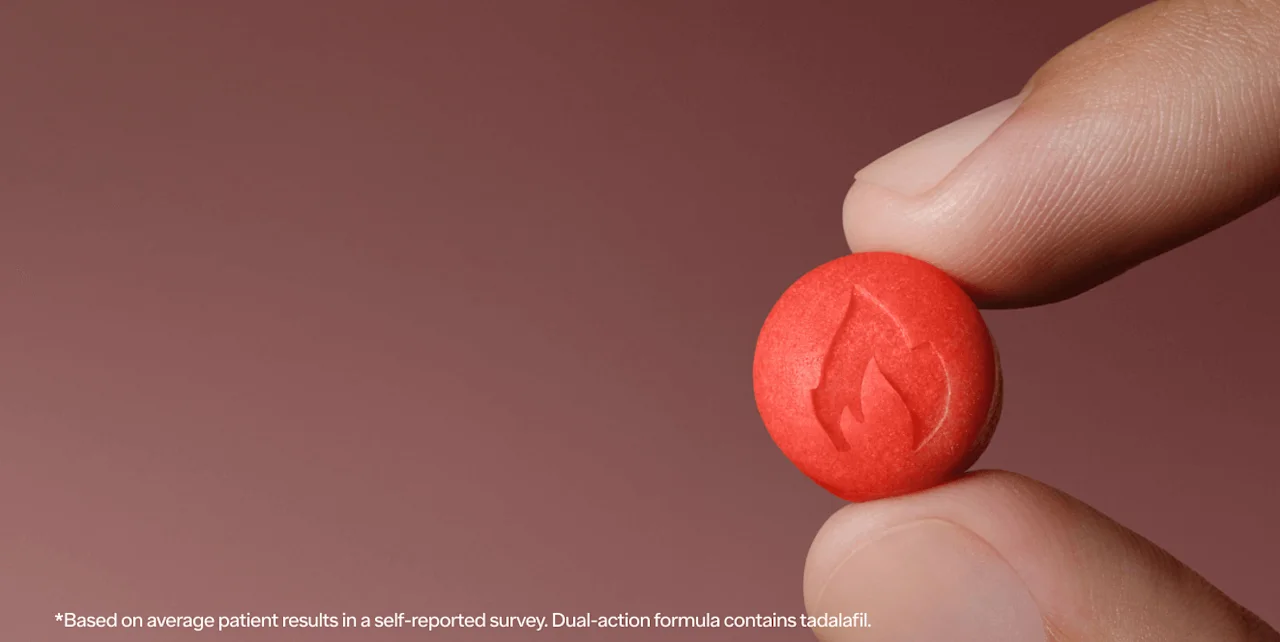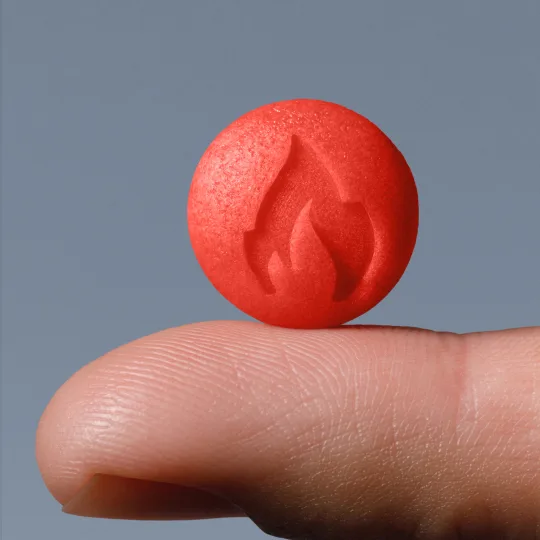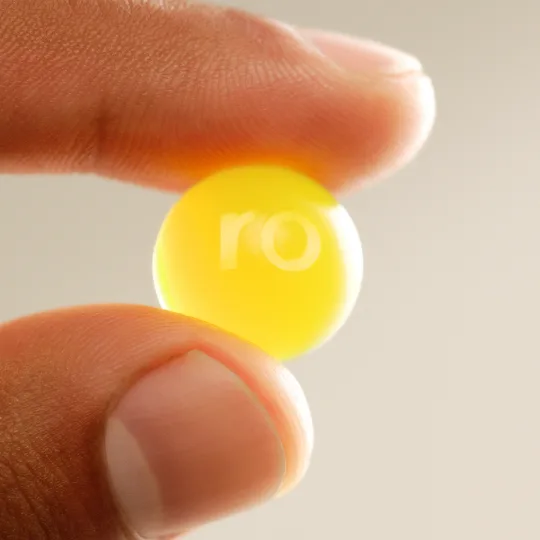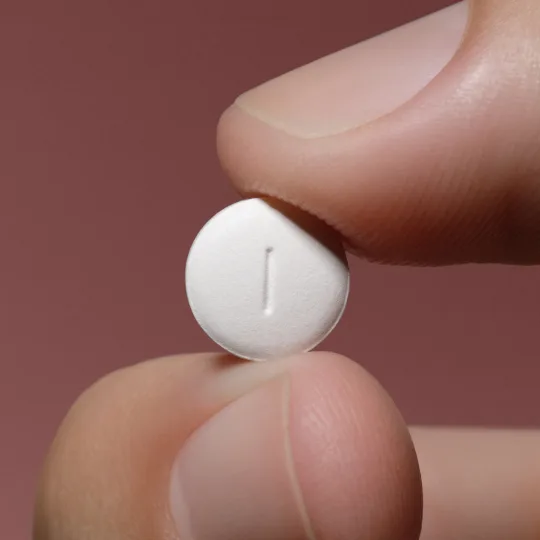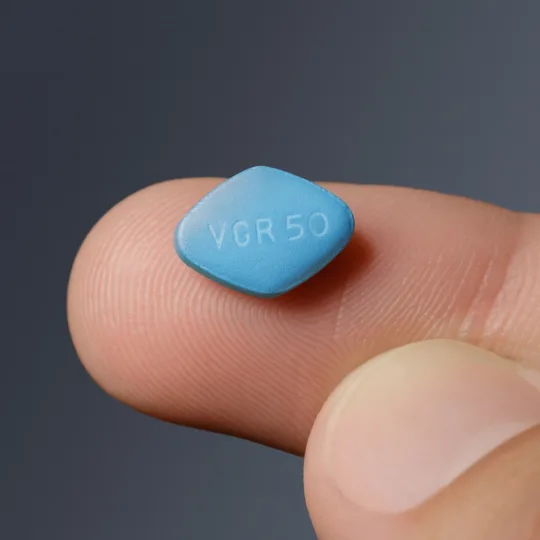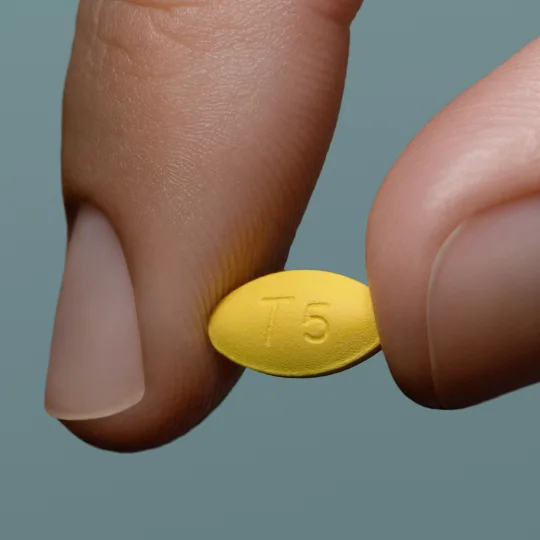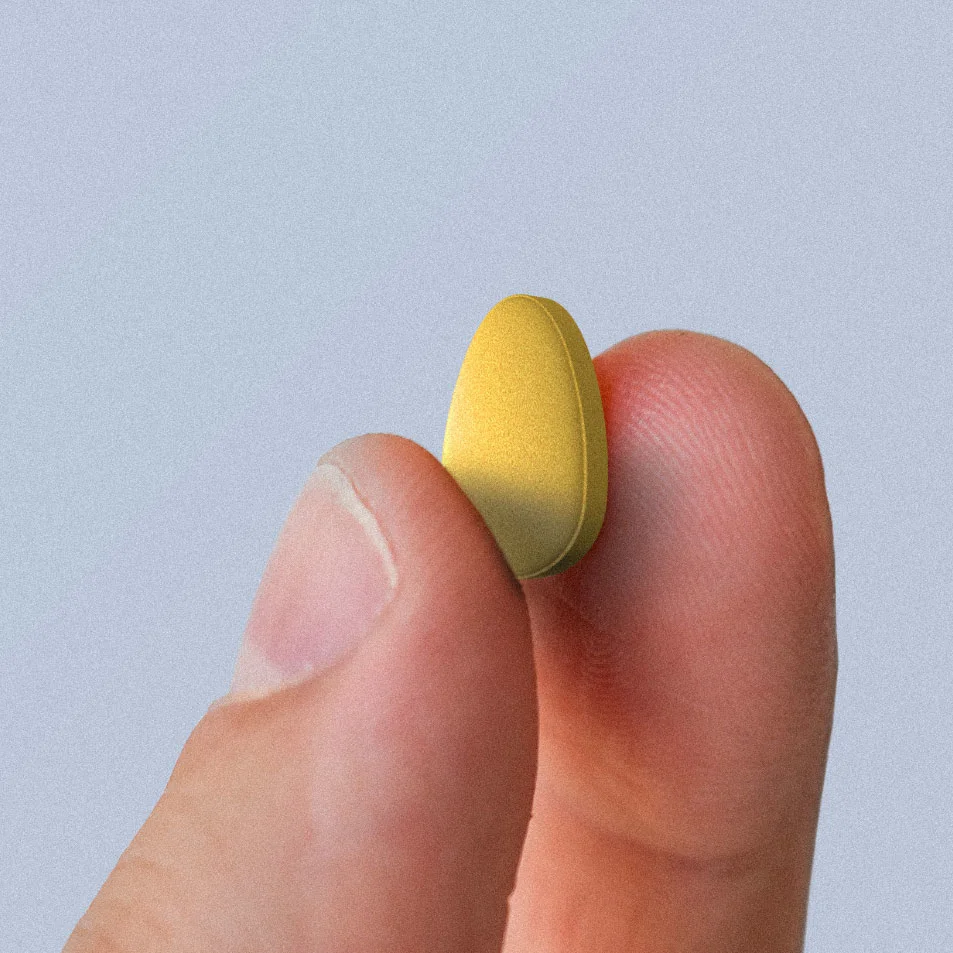Key takeaways
Tadalafil 20 mg is usually the maximum dose for as-needed treatment of erectile dysfunction (ED). It can remain effective for up to 36 hours.
While the medication improves blood flow to help you get and maintain erections, sexual stimulation is still required for it to work.
For those who prefer daily treatment, lower doses of tadalafil (2.5 mg or 5 mg) are available. This approach offers continuous effectiveness without the need to plan dosing around sexual activity.
Here's what we'll cover
Here's what we'll cover
Here's what we'll cover
Key takeaways
Tadalafil 20 mg is usually the maximum dose for as-needed treatment of erectile dysfunction (ED). It can remain effective for up to 36 hours.
While the medication improves blood flow to help you get and maintain erections, sexual stimulation is still required for it to work.
For those who prefer daily treatment, lower doses of tadalafil (2.5 mg or 5 mg) are available. This approach offers continuous effectiveness without the need to plan dosing around sexual activity.
Consistently having trouble getting or maintaining an erection can be so distressing. Not only can erectile dysfunction (ED) negatively impact your romantic relationships, it can really take a toll on your overall confidence. The good news is there are safe and effective treatments available. Enter: tadalafil (also known by its brand name, Cialis).
This drug comes in different doses, but tadalafil 20 mg is considered the maximum dose used for as-needed treatment of ED. It starts working in 30–60 minutes and can last up to 36 hours. Tadalafil is also available in a daily use option, but the dosing for that is different.
If you're considering this medication, you might be wondering how often you can take tadalafil 20 mg doses, whether it’s safe for daily use, and what side effects to expect. This guide covers everything you need to know.
What is a tadalafil 20 mg dose used for?
Tadalafil 20 mg pills are a prescription medication primarily used to treat ED—a condition where it’s difficult to get or maintain an erection firm enough for sex.
It belongs to a class of drugs called PDE5 inhibitors, which can help relax blood vessels and improve blood flow to the penis when you are aroused. Other popular PDE5 inhibitors are sildenafil (Viagra) and vardenafil.
Besides ED, tadalafil is also prescribed for:
Benign prostatic hyperplasia (BPH): This is a condition where the prostate becomes larger, leading to urinary symptoms.
Pulmonary arterial hypertension: This is a rare condition that causes high blood pressure in the lungs. For this condition, tadalafil is prescribed under the brand name Adcirca at a 40 mg dose taken once daily.
For ED, the tadalafil 20 mg dosage is the maximum dose of as-needed tadalafil for ED. It’s typically taken about 30 minutes before having sex and its effects may last up to 36 hours.
Can you take tadalafil 20 mg daily?
Tadalafil 20 mg is not typically recommended for daily use. Daily treatment usually involves lower doses like 2.5 mg or 5 mg. Though studies have found some people may be able to safely take tadalafil 20 mg daily (at least up to 12 weeks with close monitoring), it's not standard. Always consult your healthcare provider before considering daily use at this higher dose.
Tadalafil 20 mg has been shown to improve erectile function when taken once daily, according to a study involving those with both ED and lower urinary tract symptoms due to BPH (BPH-LUTS).
The study included doses of tadalafil ranging from 2.5 mg to 20 mg, and participants taking all dosages (including the 20 mg daily dose) saw significant improvements in erectile function. While the findings could be argued to support the use of tadalafil 20 mg daily for conditions like ED and BPH-LUTS, it's important to note that this daily treatment approach was studied in a specific context of combined ED and BPH, was prescribed in closely monitored conditions, and was only taken for a 12-week period.
For general ED, 20 mg is typically reserved for as-needed use, not daily treatment. If you’re considering tadalafil for daily use, lower doses (such as 2.5 mg or 5 mg) are more commonly prescribed. Always consult with your healthcare provider to determine the right dosage for your needs.
Is a tadalafil 20 mg pill the same as Cialis?
Tadalafil is the active ingredient in Cialis, meaning tadalafil 20 mg is essentially the same medication as Cialis 20 mg. The main differences are branding and price.
Cialis is the brand-name version originally developed and manufactured by Eli Lilly.
Tadalafil is the generic version, available from multiple manufacturers at a lower cost.
Both brand-name Cialis and generic tadalafil work the same way in the body, offering the same effectiveness and potential side effects. However, they may differ in appearance, inactive ingredients, and cost, depending on the manufacturer.
Tadalafil 20 mg tablets: how long do they last?
A tadalafil 20 mg pill is known for its long duration of action compared to other ED medications. It can last up to 36 hours, earning it the nickname "the weekend pill."
Keep in mind that individual results can vary with tadalafil due to your age, kidney or liver function, and if you’re taking certain other medications. In these situations, your healthcare provider may recommend a different dosage to adjust for differences in how your body processes the medication.
Here’s what you can generally expect as a timeline after taking tadalafil:
First response: 30 minutes
Some people begin experiencing effects within 15 minutes after taking the dose.
Around 52% of people can achieve successful intercourse within this timeframe.
Peak effect: Two hours
Maximum concentration is reached in the bloodstream.
Half-life: 17.5 hours
It takes about 17.5 hours for half the drug to leave your system.
This long half-life means it stays effective for an extended period of time.
Extended duration: Up to 36 hours
Effects can continue for up to 36 hours after taking the dose.
Over 70% of attempts at having sex are successful during the period between 30 minutes and 36 hours after taking tadalafil.
Because of its extended duration, tadalafil offers more flexibility in timing compared to shorter-acting ED medications like sildenafil (Viagra), which lasts around four hours. However, it should not be taken more than once per day.
What affects how long tadalafil works?
Several factors can affect how long tadalafil remains active in your system. Your individual metabolism and genetics play a role in how quickly your body processes the medication.
If you have kidney problems, for example, your body might take longer to process tadalafil, keeping it active in your system for a longer time.
Some medications can change how long tadalafil stays effective, too. Certain drugs (like some antifungal medications or HIV treatments) can make tadalafil stay in your system longer, while others (like some antibiotics) might make it leave your system more quickly.
Why use a tadalafil 20 mg tablet vs. other doses?
Tadalafil is available in multiple strengths, and each dose has different uses, onset times, and durations. Here’s a comparison chart of tadalafil dosages, along with how often you can take tadalafil 20 mg.
Dosage of tadalafil | Use | How often is it taken? | Onset time | Duration |
|---|---|---|---|---|
2.5 mg | Daily ED treatment, BPH | Once daily | Within five days of continuous use | 24 hours (constant levels) |
5 mg | Daily ED treatment, BPH | Once daily | Within five days of continuous use | 24 hours (constant levels) |
10 mg | As-needed ED treatment | As needed (max once daily) | 30 minutes to six hours | Up to 36 hours |
20 mg | Maximum as-needed ED dose | As needed (max once daily) | 30 minutes to six hours | Up to 36 hours |
A note about dosage: Never attempt to adjust your dose or choose your own dosage of tadalafil or any other ED medication. Instead, speak to your healthcare provider about what might work best for you.
Lower doses (2.5 mg, 5 mg) are intended for daily use, allowing for spontaneous sexual activity without planning around a pill.
Higher doses (10 mg, 20 mg) are taken only when needed, providing a longer effect window.
The 20 mg dose is the strongest, usually recommended only if the 10 mg isn’t effective.
The doses shown above are standard guidelines, but your healthcare provider will determine the right dose for you based on your individual medical history, current medications, and how your body processes the medication.
If you're experiencing side effects or feel your medication isn't working as well as it should, always talk to your healthcare provider. They can safely adjust your treatment plan.
The US Food and Drug Administration (FDA) has approved several strengths of tadalafil. The most popular option is the generic version of Cialis, which is approved to treat ED and BPH. It comes as an oral tablet in the following strengths: 2.5 mg, 5 mg, 10 mg, and 20 mg.
Other similar treatment options are available that offer the benefits of tadalafil in other forms. One example is Ro’s Daily Rise Gummies, a fruit-flavored once-daily gummy that provides 7 mg of tadalafil. Another is Ro Sparks, a dissolvable tablet that combines tadalafil and sildenafil. These are both off-label forms of the drug, but their active ingredients are FDA-approved for treating ED.
A healthcare provider can help determine which tadalafil dose and formula is right for you based on your needs and health history.
How to take tadalafil 20 mg?
Tadalafil 20 mg is taken by mouth about 30 to 60 minutes before you plan to have sex. The 20 mg dose is meant to be taken "on demand," or as needed, up to once a day. It's important to swallow the tablet whole and not split it in half or chew it, according to the prescribing information for Cialis.
One thing that’s important to understand is that taking tadalafil won’t result in an instant erection; it takes 30–60 minutes to kick in, and you’ll only get an erection if you’re aroused and sexually stimulated. Expecting immediate results could cause unnecessary stress or sexual performance anxiety. Patience is key, and giving the medication enough time to work helps set you up for the best results. Since a dose of tadalafil 20 mg can last up to 36 hours, you have plenty of time to work with.
You can take tadalafil with or without food, so there’s no need to worry about meal timing or delayed effects. You should be cautious about alcohol consumption, though. Both tadalafil and alcohol act as mild vasodilators (they relax blood vessels), and when combined, their blood-pressure-lowering effects can be increased.
Heavy drinking (five or more units of alcohol) with tadalafil can raise your risk of experiencing:
Drops in blood pressure that could make you dizzy
Increased heart rate
Headaches
Lightheadedness when standing up
Heavy alcohol consumption can also negatively affect erections. While having one or two drinks is typically okay for most people, it's essential to discuss your alcohol consumption with your healthcare provider, as they can give you personalized guidance based on your medical history and other medications.
Remember that a dose of tadalafil 20 mg isn’t right for everyone. The correct dose depends on your health, other medications, and how well you tolerate it. A healthcare provider can help determine whether this dose is safe for you and discuss alternatives if needed.
Tadalafil 20 mg: how long does it take to work?
According to studies of tadalafil 20 mg, it typically takes anywhere from 30 minutes to six hours for the medication to reach peak levels in the blood (though it usually peaks around 2 hours). Although tadalafil can start to have an effect as quickly as 15 minutes after taking it, most people don’t experience results that soon.
If tadalafil 20 mg does not seem to work the first time, it doesn’t necessarily mean it’s ineffective—it may take a few tries to understand how your body responds to it. If there’s still no improvement after several attempts, a healthcare provider may suggest adjusting the dosage or exploring other options.
Tadalafil 20 mg costs and where to buy
The brand-name version of the drug, Cialis, can be quite pricey, but the generic version of tadalafil 20 mg is relatively affordable. According to GoodRx, the average price for 10 tablets of generic tadalafil 20 mg ranges from $10 to $19, with a typical midrange of around $15.
Final costs can vary depending on your location, pharmacy, insurance coverage, and available discounts.
How to get a tadalafil 20 mg prescription
Because tadalafil is a prescription medication, you’ll need a healthcare provider to evaluate whether it’s right for you. There are a few ways to do this, ranging from traditional provider visits to discreet online consultations:
Visit a primary care provider: If you prefer face-to-face discussions, your regular healthcare provider can review your symptoms, medical history, and potential risk factors before prescribing tadalafil or recommending an alternative.
See a urologist: If you have ongoing ED concerns or prefer a specialist, a urologist can assess potential underlying causes like hormonal imbalances or prostate-related issues and discuss advanced treatment options if needed.
Try an online medical consultation: Many people find telehealth services a convenient way to get a tadalafil prescription without the hassle of scheduling an in-person visit. Online platforms like Ro allow you to complete a secure health assessment, consult with a licensed provider, and—if approved—get your medication discreetly at your doorstep.
Where to buy tadalafil 20 mg
Once you have a prescription, you can choose between local pharmacies, online pharmacies, and telehealth services to fill it. Each option has its advantages, depending on cost, convenience, and privacy preferences.
Local pharmacies: Traditional pharmacies, including large chains and independent locations, carry both Cialis and generic tadalafil. Prices vary, and insurance plans may help reduce costs, depending on coverage––but without insurance, the retail price can be high (much more so for Cialis than for generic tadalafil).
Online pharmacies: Some verified online pharmacies offer lower prices on generic tadalafil compared to brick-and-mortar locations. However, be cautious and only use reputable sites that require a valid prescription and are licensed in the US.
Telehealth services like Ro: If you want a straightforward and private option, services like Ro provide a seamless way to get both a prescription and the medication. Ro also offers a wide range of options, including Cialis, generic tadalafil, and alternative ED treatments like Daily Rise Gummies, which provide a steady low dose of tadalafil, and Ro Sparks, a dissolvable ED treatment that combines tadalafil and sildenafil for faster absorption.
With multiple ways to access tadalafil 20 mg, you can find a solution that works for your budget and lifestyle.
Tadalafil 20 mg side effects and warnings
Cialis (tadalafil) 20 mg side effects include:
Headaches
Indigestion
Back pain
Muscle aches
Nasal congestion
Facial flushing
To help avoid these side effects, rest and stay hydrated, avoiding coffee, tea, and alcohol. Eat simple meals and skip rich or spicy foods.
Tadalafil is generally safe when used as prescribed. Its side effects are typically mild and short-lived. However, if they persist or become more severe, it’s important to check in with your healthcare provider.
In rare cases, tadalafil can cause priapism, an erection lasting longer than four hours that won't go away on its own. This is a medical emergency that requires immediate treatment to prevent permanent damage to the penis.
Additionally, your healthcare provider should be aware if you have low blood pressure, bleeding disorders, or any heart conditions, such as angina or a history of heart attack.
If you have a history of heart problems, sexual activity may put extra strain on your heart, making it potentially unsafe. Be sure you are cleared for sexual activity before making a change to your routine.
While people with high blood pressure can typically take tadalafil safely, your healthcare provider should evaluate your blood pressure and may need to adjust your medication dosage. Always discuss any heart health concerns with your healthcare provider before starting treatment.
These are only some of the factors that play a key role in determining whether tadalafil is a safe option for you and what dosage would be most appropriate. If your healthcare provider has determined that Cialis isn’t right for you, there are several alternatives to consider.
Tadalafil alternatives
While tadalafil 20 mg pills are a widely used ED treatment, they’re not your only option. Depending on your needs—whether you want faster effects, longer duration, or a daily option that keeps you ready for spontaneous sex—there are several effective alternatives.
Medication | Time to start working | Duration | Why people choose it |
|---|---|---|---|
Viagra (sildenafil) | Usually 30 to 60 minutes | Up to four hours | Ideal for planned activity |
Vardenafil | About 30–60 minutes | Five to seven hours | Lasts slightly longer than Viagra |
Stendra (avanafil) | About 15–30 minutes | Up to six hours | Rapid onset, good for spontaneity |
Daily Cialis (tadalafil) | Steady effectiveness in the system | Ongoing | Allows for spontaneity |
Viagra (sildenafil)
Sildenafil is one of the most well-known ED medications. It can last up to about four hours, making it a reliable option for planned sex. It’s usually available in 25 mg, 50 mg, and 100 mg doses.
Vardenafil
If you’re looking for a medication that lasts slightly longer than sildenafil but still doesn’t require daily dosing, vardenafil can work for up to 5–7 hours.
It’s available in both traditional oral tablets and dissolvable tablets that melt under the tongue. Although most people take it about an hour before sex, some may feel its effects in as little as 10 minutes.
Stendra (avanafil)
For those who want fast-acting results with fewer side effects, avanafil is designed to be more selective in the body, which may reduce unwanted side effects. It can start working in as little as 15 minutes and comes in 50 mg, 100 mg, and 200 mg doses.
Daily tadalafil (Cialis)
For those who want the benefits of tadalafil without the need to take a pill right before sex, daily tadalafil provides a low-dose, once-daily option. It’s available in 2.5 mg and 5 mg doses and can help maintain a steady level of the medication in your system, allowing for more spontaneity once the medication has built up in your system (which usually happens within five days).
Learn more about how to take Cialis safely.
Daily Rise Gummies
If you prefer not having to plan around a pill, Daily Rise Gummies offer an easy, once-a-day option.
Each gummy contains 7 mg of tadalafil, which can help maintain steady levels in your system so you can be more spontaneous, without having to time your medication around sex.
Ro Sparks
For those who want fast-acting results combined with long-lasting effects, Ro Sparks combines sildenafil (55 mg) and tadalafil (22 mg) in a dissolvable tablet that can start working in about 15 minutes and can stay active for up to 36 hours.
Although Daily Rise Gummies and Ro Sparks aren’t FDA-approved in these formulations, their ingredients are individually FDA-approved for treating ED.
A healthcare provider can help determine which medication is best for you based on your symptoms, medical history, and lifestyle. To find out more about how you can make these treatments work better, let’s look at what causes ED in the first place.
What causes ED
ED is a common condition that affects many people, becoming more common with age (though anyone can experience ED at any age).
It happens when someone has trouble getting or keeping an erection firm enough for sex. While occasional difficulties with erections can be normal, persistent ED can be a sign of an underlying health issue. ED can have multiple causes, including physical health conditions, psychological factors, and lifestyle habits. In many cases, a combination of these factors contributes to the problem.
Physical causes of ED
Many health conditions can interfere with blood flow, nerve function, or hormone levels, making it harder to get an erection. Some of the most common medical causes include:
Heart disease and high blood pressure: ED is often linked to poor blood circulation and can be an early warning sign of heart disease.
Diabetes: People with diabetes are at a higher risk of ED because high blood sugar levels can damage nerves and blood vessels around the penis.
Obesity: Carrying excess weight or having obesity increases the risk of ED, likely due to reduced circulation and hormone imbalances.
Nerve-related conditions: Disorders like multiple sclerosis, Parkinson’s disease, and spinal cord injuries can disrupt nerve signals needed for erections.
Prostate issues and surgery: Treatments for prostate cancer or an enlarged prostate can affect erectile function.
Medication side effects: Some prescription drugs, including certain antidepressants, blood pressure medications, and opioids, can contribute to ED.
Peyronie's disease: This condition causes scar tissue to form in the penis, leading to curved, painful erections that can make sexual activity difficult and contribute to ED.
Low testosterone (hypogonadism): While not the most common cause, low testosterone can affect sexual function, especially in people with other health issues.
Psychological causes of ED
ED isn’t always caused by a physical problem. Mental health and emotional wellbeing can play a role in sexual function. Stress, anxiety, and depression can make it harder to get or maintain an erection. Here are some possible psychological causes of ED:
Performance anxiety: Worrying about sexual performance can create a cycle of stress that makes ED worse. This can also contribute to premature ejaculation, which can co-occur with ED.
Depression: Those with depression are more likely to experience ED, and ED can also contribute to feelings of low self-esteem.
Relationship problems: Communication issues, unresolved conflicts, or a lack of emotional connection with a partner can affect sexual function.
Lifestyle factors that can contribute to ED
Certain habits and lifestyle choices can also increase the risk of ED. Some common causes include:
Smoking: Tobacco use causes restrictions to blood flow throughout the body, including the penis, which can lead to ED. Quitting smoking has been shown to improve erectile function over time.
Excessive alcohol consumption: While drinking in moderation is usually fine, heavy alcohol use can interfere with your body’s signals and blood flow.
Lack of physical activity: Regular exercise helps improve circulation, heart health, and hormone balance—all important for sexual function.
The main thing to remember is that ED is not just about sex—it can be a sign of underlying health problems. Studies show that those with ED may have a higher risk of heart disease, stroke, and other cardiovascular issues.
In some cases, ED shows up years before heart problems develop, making it an important condition to discuss with a healthcare provider.
Bottom line: is tadalafil 20 mg dosage right for you?
Finding the right tadalafil dose is all about balancing effectiveness and side effects, while considering your lifestyle and preferences. Whether you're new to ED treatments or adjusting your current plan, understanding how the 20 mg option compares can help you make a more confident choice. Here’s what to keep in mind about tadalafil 20 mg:
It’s considered the strongest as-needed dose for ED: If lower doses like 5 mg or 10 mg haven’t worked well for you, your healthcare provider may recommend the 20 mg option.
Daily use is better suited to lower doses: The 20 mg dose isn’t normally intended for daily use. If you’re looking for a daily treatment that can keep you ready for sex more spontaneously, lower doses like 2.5 mg or 5 mg are safer and more appropriate for that use case.
Watch for side effects at higher doses: While the 20 mg dose can be effective, it may also increase the chance of side effects like headaches, muscle aches, or back pain. If you experience these, a lower dose or an alternative medication might be better suited for you.
There are alternative treatments if tadalafil isn’t the right fit: Other options like sildenafil (Viagra) or vardenafil might align better with your needs. Or, combination treatments like Ro Sparks (which blends tadalafil and sildenafil) or Daily Rise Gummies offer additional ways to treat your ED.
Talking with your provider ensures you find a treatment that’s safe, effective, and fits your lifestyle—whether that’s tadalafil 20 mg or something else. With the right guidance and approach, you can find a treatment that fits your needs and helps you feel confident about sex again.
Have better sex with Ro
Frequently asked questions (FAQs)
How often can you take tadalafil 20 mg?
Tadalafil 20 mg should be taken as needed for ED, no more than once per day. If you want to take tadalafil daily to allow for more spontaneity, a lower dose is more appropriate, since tadalafil 20 mg’s effects can last up to 36 hours. Always follow your healthcare provider’s instructions on how often to take it safely.
Is 20 mg Cialis equal to 100 mg Viagra?
Not exactly. Cialis (tadalafil) and Viagra (sildenafil) work differently in the body, even though they both treat ED.
The main difference is how long they last—Viagra can typically work for four to six hours, while Cialis can stay active for up to 36 hours.
While 20 mg of Cialis and 100 mg of Viagra are both the highest standard doses for each medication, they are not directly interchangeable. If you’re unsure which option is best for you, your healthcare provider can help you decide based on your needs and medical history.
Get detailed safety information on Viagra.
How many 20 mg tadalafil should I take?
Take just one tablet per day, and only when needed. Tadalafil 20 mg is the maximum recommended as-needed dose, and taking more than one dose in a 24-hour period won’t make it work better—it only increases the risk of side effects.
If you’re wondering whether you can take tadalafil 20 mg daily, or if tadalafil 20 mg isn’t working well for you, don’t increase the dose on your own.
Instead, speak with a healthcare provider to explore other options, like adjusting your dosage, switching medications, or trying a daily low-dose version for more consistent effects.
What do I do if tadalafil 20 mg is not working?
If tadalafil 20 mg isn’t working as expected, there could be a few reasons why. Timing is important—make sure you're taking it at least 30 minutes before sex, but know that it can take up to six hours to reach its full effects in some people.
Also, sexual stimulation is necessary—tadalafil won’t cause an automatic erection. Arousal and stimulation are still required.
If you've followed all guidelines and tadalafil still isn’t working after multiple attempts, it's best to talk to a healthcare provider. They can help determine whether you need a different ED medication, a dosage adjustment, or treatment for an underlying condition that might be impacting your sexual health.
DISCLAIMER
If you have any medical questions or concerns, please talk to your healthcare provider. The articles on Health Guide are underpinned by peer-reviewed research and information drawn from medical societies and governmental agencies. However, they are not a substitute for professional medical advice, diagnosis, or treatment.
Cialis Important Safety Information: Read more about serious warnings and safety info.
Viagra Important Safety Information: Read more about serious warnings and safety info.
References
Coward, R. M. & Carson, C. C. (2008). Tadalafil in the treatment of erectile dysfunction. Therapeutics and Clinical Risk Management, 4(6), 1315–1330. doi: 10.2147/tcrm.s3336. Retrieved from https://pmc.ncbi.nlm.nih.gov/articles/PMC2643112/
Dhaliwal, A. & Gupta, M. (2023). PDE5 inhibitors. StatPearls. Retrieved on Apr. 5, 2025 from https://www.ncbi.nlm.nih.gov/books/NBK549843/
Eli Lilly and Company. (2023). Cialis (tadalafil) tablets, for oral use: Highlights of prescribing information. Retrieved from https://pi.lilly.com/us/cialis-pi.pdf
Evans, J. D. & Hill, S. R. (2015). A comparison of the available phosphodiesterase-5 inhibitors in the treatment of erectile dysfunction: A focus on avanafil. Patient Preference And Adherence, 9, 1159–1164. doi: 10.2147/PPA.S56002. Retrieved from https://pmc.ncbi.nlm.nih.gov/articles/PMC4542406/
Fahmy, G. & Hess, J. (2025). Tadalafil. StatPearls. Retrieved on Apr. 5, 2025 from https://www.ncbi.nlm.nih.gov/books/NBK603743/
GoodRx. (n.d.). Tadalafil (Cialis). Retrieved from https://www.goodrx.com/cialis?form=tablet&dosage=20mg&quantity=10&label_override=tadalafil-cialis
Jackson, G. (2013). Erectile dysfunction and cardiovascular disease. Arab Journal Of Urology, 11(3), 212–216. doi: 10.1016/j.aju.2013.03.003. Retrieved from https://pmc.ncbi.nlm.nih.gov/articles/PMC4442980/
Katz, E. G., Tan, R. B., Rittenberg, D., et al. (2014). Avanafil for erectile dysfunction in elderly and younger adults: Differential pharmacology and clinical utility. Therapeutics and Clinical Risk Management, 10, 701–711. doi: 10.2147/TCRM.S57610. Retrieved from https://pmc.ncbi.nlm.nih.gov/articles/PMC4155803/
Kedia, G. T., Uckert, S., Assadi-Pour, F., et al. (2013). Avanafil for the treatment of erectile dysfunction: Initial data and clinical key properties. Therapeutic Advances in Urology, 5(1), 35–41. doi: 10.1177/1756287212466282. Retrieved from https://journals.sagepub.com/doi/10.1177/1756287212466282
Leslie, S. W. & Sooriyamoorthy, T. (2024). Erectile dysfunction. StatPearls. Retrieved on Apr. 5, 2025 from https://www.ncbi.nlm.nih.gov/books/NBK562253/
Porst, H., McVary, K. T., Montorsi, F., et al. (2009). Effects of once-daily tadalafil on erectile function in men with erectile dysfunction and signs and symptoms of benign prostatic hyperplasia. European Urology, 56(4), 727–735. doi: 10.1016/j.eururo.2009.04.033. Retrieved from https://pubmed.ncbi.nlm.nih.gov/19409693/
Rosen, R. C., Padma-Nathan, H., Shabsigh, R., et al. (2004). Determining the earliest time within 30 minutes to erectogenic effect after tadalafil 10 and 20 mg: a multicenter, randomized, double-blind, placebo-controlled, at-home study. Journal of Sexual Medicine, 1(2), 193-200. doi: 10.1111/j.1743-6109.2004.04028. Retrieved from https://pubmed.ncbi.nlm.nih.gov/16422974/
U.S. Food and Drug Administration (FDA). (2017). Adcirca (tadalafil) tablets, for oral use: Highlights of prescribing information. Retrieved from https://www.accessdata.fda.gov/drugsatfda_docs/label/2017/022332s009lbl.pdf
U.S. Food and Drug Administration (FDA). (2018). Cialis (tadalafil) tablets, for oral use: Highlights of prescribing information. Retrieved from https://www.accessdata.fda.gov/drugsatfda_docs/label/2018/021368s030lbl.pdf
U.S. Food and Drug Administration (FDA). (2017). Highlights of prescribing information: Viagra (sildenafil citrate) tablets, for oral use. Retrieved from https://www.accessdata.fda.gov/drugsatfda_docs/label/2017/020895s048lbl.pdf
Wang, X., Bai, Y., Yang, Y. et al. (2018). Alcohol intake and risk of erectile dysfunction: a dose-response meta-analysis of observational studies. International Journal of Impotence Research, 30(6), 342-351. doi: 10.1038/s41443-018-0022-x. Retrieved from https://pubmed.ncbi.nlm.nih.gov/30232467/



